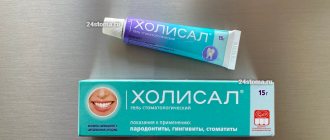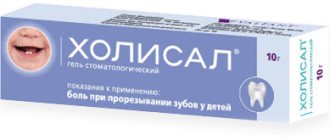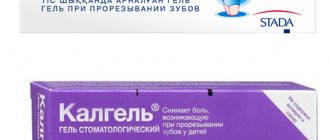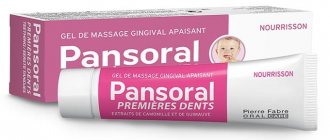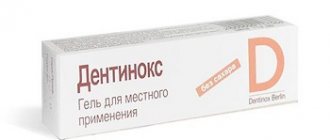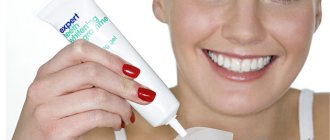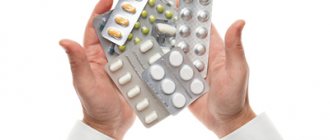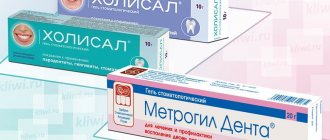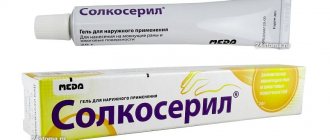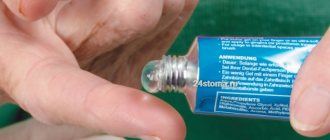Gum inflammation is accompanied by a number of painful symptoms that not only affect your well-being, but also affect your ability to chew and speak normally. To eliminate unpleasant signs in dentistry, special gels are used. They act directly on the oral mucosa and are slightly absorbed into the blood, which makes them safe for children.
Painkillers and anti-inflammatory gels can be used during teething (Baby Doctor) and for complex treatment of gingivitis or stomatitis.
Nosological classification (ICD-10)
- B37.0 Candidal stomatitis
- K00.7 Teething syndrome
- K05 Gingivitis and periodontal diseases
- K12 Stomatitis and related lesions
- K13.0 Diseases of the lips
- K13.7 Other and unspecified lesions of the oral mucosa
- L43.9 Lichen planus, unspecified
- L51.9 Erythema multiforme, unspecified
- Z100* CLASS XXII Surgical practice
- Z97.2 Presence of dental prosthetic device (complete) (partial)
Cheap analogues of Cholisal gel -
We have already said above that the price for Cholisal gel is from 470 rubles (per tube of 15 g), which makes this drug not very accessible to the general population, given that the consumption of the drug for a course of treatment can be 2 tubes. Therefore, below we will talk about a drug that, in its action, can be considered a relative analogue of Cholisal. We are talking about the gel “PERIODONTOCIDE”.
Let us remind you that Cholisal contains a salicylic acid derivative such as choline salicylate. In turn, Parodontocid gel contains a substance from the same group – phenyl salicylate. And below you can find out more about this drug.
Pharmacodynamics
Choline salicylate has analgesic, anti-inflammatory and antipyretic effects. It inhibits the activity of cyclooxygenase, the functions of macrophages and neutrophils, the production of interleukin-1 and inhibits the synthesis of PG. It also has antimicrobial and antifungal effects (in acidic and alkaline environments).
The analgesic effect appears within 2–3 minutes and lasts 2–8 hours.
Cetalkonium chloride has an antiseptic effect on bacteria, fungi and viruses.
Cholisal does not contain sugar, does not have a local irritating effect and is well tolerated by patients.
Gel Cholisal - patient reviews
Reviews of Cholisal gel from patients and specialists are usually only positive. But! As a periodontist, patients periodically came to me to self-medicate their gums, including with the drug Cholisal. And when, after removing dental plaque, I recommended Cholisal to them (as part of a course of anti-inflammatory therapy), some of the patients said that this was a bad, too expensive and ineffective drug.
The reason for the bad reviews in this case is solely due to errors in the use of the drug. The fact is that, faced with another exacerbation of gum inflammation, patients forget that the reason for this is soft microbial plaque + tartar. If you start using the drug without first removing plaque, the effectiveness of the gel will be significantly lower, and the effect itself will not last long (24stoma.ru).
Therefore, if you want to get truly truly effective therapy, before using Cholisal gel you need to make an appointment with a periodontist for ultrasonic teeth cleaning. After removing dental plaque, the doctor will prescribe you a course of anti-inflammatory therapy (consisting of antiseptic rinses and gel applications on the gums), which you can carry out independently, using the doctor’s recommendations.
Advantages of the drug Cholisal -
- very good anti-inflammatory/antimicrobial activity,
- relieves pain well and quickly,
- the gel adheres well to the mucous membrane,
- the active components of Cholisal act not only on the surface of the mucous membrane, but also penetrate well into the inflamed tissues.
Disadvantages of the drug -
- high price,
- has the taste and smell of anise, which leads to an increase in salivation (in adults this is not critical, but in infants it can cause numerous inconveniences - drooling from the mouth, irritation of the skin around the mouth, and you definitely need to monitor the baby to avoid choking on saliva) .
Indications for the drug Cholisal®
Infectious-inflammatory, ulcerative-necrotic, trophic diseases of the oral mucosa: stomatitis of various etiologies, gingivitis, periodontitis, damage to the mucous membrane when wearing dentures, trauma to the oral mucosa, pain during teething in children, glandular cheilitis, thrush, small surgical interventions, lichen planus, exudative erythema multiforme (including Stevens-Johnson syndrome) - as part of complex therapy.
Metrogil Denta
Contains an antibacterial substance - metronidazole and an antiseptic - chlorhexidine. It is used to relieve gum pain during stomatitis, after dental treatment, during an inflammatory process due to infection or traumatic injury.
The gel is practically not absorbed, therefore it is safe for treating the oral mucosa of a child. But at the same time, the low concentration of the active ingredient makes it not the most effective against severe inflammation; after treatment, there may be a relapse.
Interesting facts about teeth
- The first teeth were called “milk” by Hippocrates. The name is directly related to breastfeeding. The great philosopher believed that they are formed only through breastfeeding. He was right! Without the huge proportion of calcium contained in mother's milk, the formation of not only milk teeth, but also molars is impossible.
- Teeth remain healthy only thanks to saliva. It normalizes the acid-base balance and kills germs.
- Prosthetics for damaged teeth began in ancient times in Egypt and Rome. They used both animal teeth as crowns and structures made of expensive metals in the form of bridge prostheses.
Recommendations
Reviews and instructions for the Cholisal gel are only general in nature - for various diseases there are certain features of using the product. That is why it is best to consult a dentist before use.
For example, if periodontitis or gingivitis is detected, the product is used exclusively as part of a comprehensive treatment. If you neglect this rule and use the medication without removing plaque and tartar, the inflammation will decrease, but then become chronic, which can lead to the destruction of bone tissue. The standard therapeutic course lasts approximately 10 days.
In the case of stomatitis treatment, it is advisable to use a gel to reduce pain in the erosion zone. The remedy will not cope with the ulcers themselves, especially the aphthous or herpetic type. In case of wisdom teeth eruption, the gel helps eliminate pain, but before using it you need to make sure that there is no pus in the hood and that the cheek is not swollen. If such symptoms occur, you should go to a surgeon rather than try to correct the situation with medications.
Peculiarities
Often the medicine is used as a preventive measure to prevent various injuries. It is advisable to use the product, for example, when wearing dental onlays, braces, or dentures. After all, because of them, the oral cavity is regularly damaged, in particular, the inner side of the cheeks and gums. Although numerous ulcers, wounds and cracks may appear due to exposure to other conditions:
- overly susceptible mucous membrane;
- improper brushing of teeth;
- eating food that injures the surface, for example, crackers, nuts, chips, seeds;
- smoking, which worsens the general condition of the mouth;
- metabolic pathologies.
Systematic use of Cholisal gel improves blood flow in tissues. They gradually begin to receive biologically active substances and nutritional products. Injured cells are regenerated quite quickly, and tissue healing is significantly accelerated.
Possible unwanted effects
The instructions prescribe using the drug with caution during pregnancy and breastfeeding, that is, the product must be recommended by a specialist, which involves monitoring its use and abandoning the gel, if necessary.
Thus, domestic medicine does not prescribe treatment with Cholisal gel during the first trimester of pregnancy.
Complications and negative consequences when using Cholisal gel were observed by practicing doctors extremely rarely. However, increased individual sensitivity to the ingredients of the drug can manifest itself as:
- not a strong burning sensation in the areas where the product was applied;
- redness;
- itching
These side effects most often disappear within a few minutes.
However, when the first unwanted symptoms appear, experts recommend stopping using the gel, since the cause of an allergic reaction may be:
- salicylates;
- anise oil,
as well as other ingredients included in the product.
In addition, dentists advise using the optimal amount of the drug during procedures, avoiding overdose.
In addition, it should be taken into account that the use of cholisal with other analgesics, anti-inflammatory drugs, antipyretic syrups can increase the concentration of active substances in the body, and an excess of antibiotics and antiseptics can also cause an allergic reaction.
Considering the free sale of Cholisal gel in pharmacies, before purchasing and using the drug, you should consult with a specialist, which will allow you to use the modern combined action product most effectively.
Application
Apply a small amount of gel to the affected area and rub gently for 2 minutes. apply 2-3 times a day. A column of gel 1 cm long for adults and 0.5 cm for children is carefully rubbed into the affected area of the mucous membrane for several minutes.
When treating periodontal diseases, the gel should be placed 1–2 times a day in the gum pockets, and also applied in the form of compresses or gently rubbed into the gums 1–2 times a day. The duration of treatment is determined depending on the clinical situation. For 30 minutes after using the gel, do not rinse your mouth with water or eat food.
For stomatitis
In the treatment of stomatitis, Cholisal gel is usually prescribed to reduce the pain of ulcers accompanying the course of the disease, however, the use of this remedy alone does not cure the disease, since the active substances of the drug are not able to fight herpes viruses, which are mainly the causative agents of this disease .
The allergic form of stomatitis must be treated by other means, therefore, for such diagnoses, these compounds are used only for symptomatic therapy.
Overdose
Theoretically impossible. however, if this happens, rinse your mouth with plenty of water and induce vomiting if necessary.
In case of hypersensitivity to salicylates, after an overdose of the gel and absorption of a significant amount of choline salicylate into the body, symptoms of systemic action of salicylates may appear: increased sweating, tinnitus, nausea, vomiting, dizziness, skin rash (erythema or urticaria). Treatment is symptomatic.
Pharmacological properties
The effects of the drug are due to the synergistic effect of its components: anti-inflammatory, analgesic and antiseptic.
the main active ingredient of the drug, choline salicylate, has a local anti-inflammatory and mild analgesic effect. The mechanism of the analgesic, antipyretic and anti-inflammatory action of salicylates is associated with inhibition of the activity of cox, as well as the activity of thromboxane synthetase. as a result, the synthesis of prostaglandins is inhibited, primarily prostaglandins e and f in tissues altered by inflammation, in the wall of the gastrointestinal tract and kidneys. used locally, in normal doses does not have a systemic effect. Cetalkonium chloride enhances the analgesic and anti-inflammatory effect. antiseptics included in the gel base, methyl parahydroxybenzoate and propyl parahydroxybenzoate (in concentrations of 0.15 and 0.08%, respectively), have an antibacterial effect. Choline salicylate quickly penetrates the mucous membranes (approximately 2 times faster than acetylsalicylic acid). Salicylates easily penetrate most tissues and body fluids. They have a high affinity for blood proteins and tissues, binding (50–80%) to blood plasma albumins. T½ of salicylates - 2-4 hours. Biotransformation of salicylates occurs in tissues, mainly in the liver to salicylic acid, from which salicylamic acid, glucuronides, acetal, and gentisic acid are formed. Biotransformation products are excreted in the urine (75% is salicylic uric acid). About 10% of salicylates are excreted unchanged in the urine. Excretion occurs slowly, about 50% of the dose is eliminated within 24 hours.
